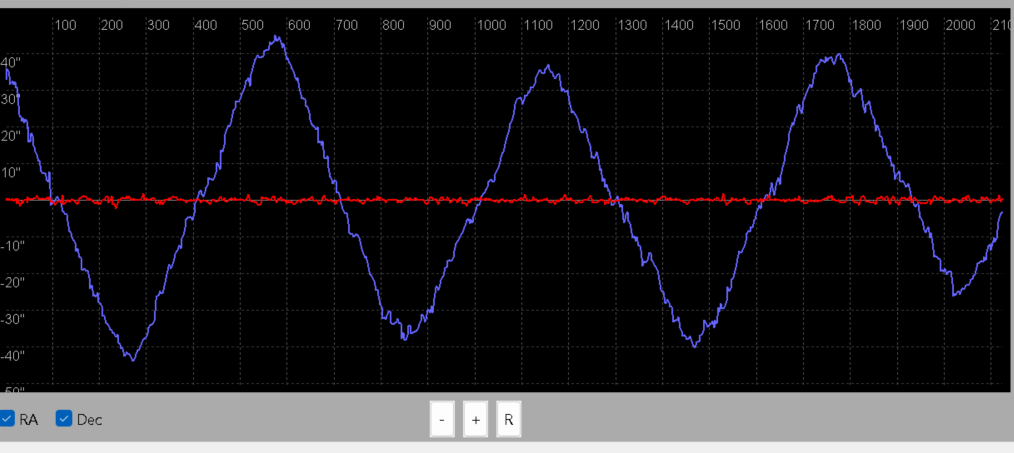GEM28 guiding performance
Rick Cohen
Brian Valente



--
You received this message because you are subscribed to the Google Groups "Open PHD Guiding" group.
To unsubscribe from this group and stop receiving emails from it, send an email to open-phd-guidi...@googlegroups.com.
To view this discussion on the web visit https://groups.google.com/d/msgid/open-phd-guiding/6bc7b41d-4677-4c6c-b77c-bc263c3a7e8bn%40googlegroups.com.
Rick Cohen
Rick Cohen
bw_m...@earthlink.net
You can’t try to use a saturation setting that doesn’t match the data being returned by the camera driver. The drivers return data in either 8 or 16-bit modes. For a camera with 12 or 14-bit electronics, the driver will still scale the data into either 8-bit or 16-bt values depending on whether you’ve told it to run in 8 or 16 bit modes. That’s a camera driver setting, not something in PHD2. If you’re not having problems, you can probably just leave things alone.
Bruce
From: open-phd...@googlegroups.com <open-phd...@googlegroups.com> On Behalf Of Rick Cohen
Sent: Friday, August 12, 2022 9:49 AM
To: Open PHD Guiding <open-phd...@googlegroups.com>
Subject: Re: [open-phd-guiding] GEM28 guiding performance
I noticed in the Debug Log that the bpp for the camera is returning 8 bits and that in the brain section for the camera the Saturation by MAX ADU-Value is 255. The specs say that the ASI290mm mini is 12-bit output. Is this something I should be concerned with? There are some threads on Cloudy Nights where others have commented that this camera runs better in 8 bit mode. I tried setting the Max ADU value to 65535, but it doesn't stick.
On Tuesday, August 2, 2022 at 7:07:48 PM UTC-6 bval...@gmail.com wrote:
Hi Rick
thanks for uploading the guidelog and having some good data including a calibration
I agree your primary periodic error seems pretty significant and appears to be the limiting factor
Here is your residual guiding error - this is what is left after all the corrections are applied:
you can see the 596-ish sec period is not able to be guided out
this results from a large primary pe of the same period of around 33" - which is huge and imo probably well outside the spec of that mount.
at this point your PHD setup looks pretty good, so next step would be to look at mechanical improvements on the primary periodic error
good luck
Brian
On Tue, Aug 2, 2022 at 5:43 PM Rick Cohen <ricr...@gmail.com> wrote:
About the best guiding I can get is around 1.5" total RMS. It seems like a lot of that might be due to a high RA periodic error. I think that it's much higher than the iOptron specs.
I'm assuming that the periodic error can be reduced by addressing mechanical issues and/or recording PEC.
Does this log suggest anything else I can do to better my guiding?
Any suggestions are welcome.
I'm imaging with a William Optics Z61 and ASI 183MC camera. Guiding is with a ZWO OAG and ASI290MM mini camera.
--
You received this message because you are subscribed to the Google Groups "Open PHD Guiding" group.
To unsubscribe from this group and stop receiving emails from it, send an email to open-phd-guidi...@googlegroups.com.
To view this discussion on the web visit https://groups.google.com/d/msgid/open-phd-guiding/6bc7b41d-4677-4c6c-b77c-bc263c3a7e8bn%40googlegroups.com.
--
Brian
Brian Valente
astro portfolio https://www.brianvalentephotography.com/astrophotography/
portfolio brianvalentephotography.com
--
You received this message because you are subscribed to the Google Groups "Open PHD Guiding" group.
To unsubscribe from this group and stop receiving emails from it, send an email to open-phd-guidi...@googlegroups.com.
To view this discussion on the web visit https://groups.google.com/d/msgid/open-phd-guiding/6a9fcd75-81c9-42d0-aefe-c427d001204an%40googlegroups.com.
